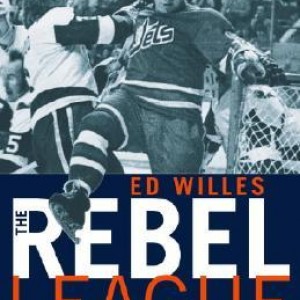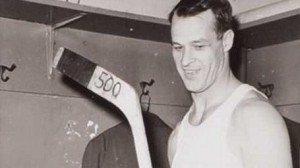The Rebel League: The Short and Unruly Life of the World Hockey Association by sports columnist Ed Willes is the go-to guide for the history of the WHA. Filled with a deep understanding of the game, his book is a tribute to the league that changed the game of hockey in North America.
Willes uses first hand sources to allow readers the chance to catch a glimpse of just how the league came to be, from the start-up to the eventual merger with the NHL.
Coming to fruition in 1972, the league was the brain-child of  money-man Dennis Murphy and lawyer Gary Davidson. The two ventured into sports in the past- the American Basketball Association was the pair’s handy work. After countless unsuccessful meetings with potential investors in the league, Murphy was introduced to Bill Hunter, then president of the Junior Western Canadian Hockey League. As any Edmonton Oilers fan can tell you, Murphy is responsible for the NHL coming to Edmonton and the construction of the Northlands Coliseum (now Rexall Place). The three then began to tour North America in hopes of finding investors.
money-man Dennis Murphy and lawyer Gary Davidson. The two ventured into sports in the past- the American Basketball Association was the pair’s handy work. After countless unsuccessful meetings with potential investors in the league, Murphy was introduced to Bill Hunter, then president of the Junior Western Canadian Hockey League. As any Edmonton Oilers fan can tell you, Murphy is responsible for the NHL coming to Edmonton and the construction of the Northlands Coliseum (now Rexall Place). The three then began to tour North America in hopes of finding investors.
The investor search went… well, it’s more than complicated and it would be best to just let Willes explain it in the book.
After all the teams were settled, which as you’ll read, the teams were never really settled, there was a draft, which is a hilarious story all its own. The 12 teams picked a variety of players, most of which were amateur, but there were a handful of professional and retired players picked as well.
The Rebel League Had Its Stars
Here’s a few WHAers you might recognize: Bernie Parent, Gerry Cheevers, Paul Shmyr, Al Hamilton, Rick Dudley, Barry Melrose, Bobby Hull, Gordie Howe, Mark Howe, Marty Howe, Rob Ramage, Harry Neale, Jacques Demers, Mark Messier, Wayne Gretzky, Glen Sather, J.C. Tremblay, Al Smith… the list goes on and on.
The main appeal of joining the WHA for minor league and junior level players (and even some pros) was the money. At the time, most amateurs were making around $12 thousand a year- the average WHA contract was $30 thousand a year (except for Bobby Hull who was given a $1 million signing bonus for joining up with the Winnipeg Jets!). It’s easy to see why so many players decided to go with the rebel league.
The WHA also challenged, and ultimately defeated, the reverse clause set up by the NHL. The reverse clause basically stated that no matter what, a player’s contact could be extended indefinitely. Not exactly a fair deal by anyone’s standards, the WHA fought the NHL in court and won. Thus begins the epic battle between the WHA and the NHL that lasted all seven of the rebel leagues seasons.
Besides the money issue, another interesting aspect of the league mentioned by Willes was the way it paved the way for the current NHL. The WHA broke down the barriers that the US and Canada had with the European market and introduced North America to a whole slew of talented puck-masters, like Swedish superstars Anders Hedberg and Ulf Nilsson.
A great excerpt from the book is the story about the first time Bobby Hull, then with the Winnipeg Jets, first skated with the newly acquired Hedberg and Nilsson.
“I just picked up the puck in the corner, and these two guys sprang from the other side,” says Hull. “Then it was bing-bing-bing and in the net and I just said, ‘What the f*** have we got here?’”
“We were doing these line rushes against a college team, and we couldn’t miss,” says Hedberg. “I said to Ulfie after the practice, ‘This is unbelievable! I wonder what Bobby is thinking?’ Bobby had rushed home and called [Jets team doctor] Jerry Wilson. He said, “This is unbelievable! I wonder what the Swedes are thinking?’”
The three would make up one of the greatest and most influential lines in the history of hockey, the Hot Line. Hull brought knowledge and a  cannon of a shot to the line, while Hedberg brought intense speed to the mix. Nilsson was a master of the pass and the lines set-up man.
cannon of a shot to the line, while Hedberg brought intense speed to the mix. Nilsson was a master of the pass and the lines set-up man.
To show just how influential the line was, all one has to do is go to the stats. In his first year playing with the Swedes, Hull potted 77 goals and 142 points; he tallied 53 goals and 95 points the previous season.
Willes also explains how the European players in the league were a crowd favorite (this is the time of the Canada-Russia Summit Series), bringing the average attendance of games up as more were added to each club. The foreigners, however, weren’t welcomed by everyone. Hedberg and Nilsson attribute their less than stellar NHL careers to the beatings they took every night while playing in the WHA.
Besides all the history, Willes knows what his audience craves: absurd hockey stories. Mid-game arrests? Check. Naked hallway fights with fans? Check. Goalies getting caught eating hot dogs on the bench? Check. Arenas that smell like the slaughterhouse? Check. There are too many to mention here, but some of them we already know… that is if you’ve ever seen the epic hockey flick Slap Shot.
A good deal of the hijinks in Slap Shot are directly taken from stories from the WHA. The Hanson brothers were actually the Carlson brothers, who played with the Minnesota Fighting Saints instead of the Charlestown Chiefs. Ogie Oglethorpe was based on WHA rough-man Bill Goldthorpe. Yes, there was lots of drinking in the WHA and yes, every single team was in dire straits when it came to money. It’s all in the book!
But in the end, the WHA is best described by Willes in this simple paragraph:
“No one seems to remember the WHA wrestled the game away from a handful of NHL owners and took it to new markets, that it opened the door for Europeans, and that it offered a generation of players their first chance at a real payday.”
The WHA was a league full of extravagant owners who had teams full of goons, kids, old-timers, foreigners and a handful of talented forwards, defensemen and netminders. The WHA bumped the average salary for minor-leaguers from $12 thousand dollars a season to $30 thousand. It destroyed the reverse clause, brought hockey to the south and west coast, and gave kids like Wayne Gretzky and Mark Messier a chance to play at their elite level with other elite players. It also gave players like Gordie Howe a chance to prove that age doesn’t matter.
Willes’ book is a must read for any hockey fan. Plus, where else can you read about a line that featured Gordie and Mark Howe playing alongside Wayne Gretzky?
Note to self: Hit Amazon next pay day…Excellent interview for what looks like a good read!